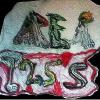Thanks for the writeup.
What dose of Kutaj do/did you take (mg would be helpful), what were the subjective effects and how long did they last?
Also what cyto/hepatotoxicity concerns do you think there are based off of these two studies?
There is a paucity of data on the occurrence of hepatotoxic and hepatocarcinogenic pyrrolizidine alkaloids in medicinal plants, and there are no data on the hepatotoxic properties of herbal medicines that are used in the traditional pharmacopoiea of Sri Lanka and other Asian and African countries. In view of the extensive consumption of these herbs and the occurrence of chronic liver diseases including hepatocellular cancer in this and other countries of South Asia, we have screened fifty medicinal plants for pyrrolizidine alkaloids and have obtained positive results with three species, namely Crotalaria verrucosa L., Holarrhena antidysenterica (L.) Br., and Cassia auriculata L. Feeding trials in rats with materials from these three species produced liver lesions--disruption of the centrilobular veins, congestion or haemorrhage in the centrilobular sinusoids, centrilobular or focal hepatocellular necrosis--and histopathology in the lungs and kidneys which were compatible with the action of pyrrolizidine alkaloids. The presence of alkaloids in C. auriculata has not been previously reported nor has the presence of pyrrolizidine alkaloids in H. antidysenterica. It is suggested that the consumption of herbal medicines that contain pyrrolizidine alkaloids could contribute to the high incidence of chronic liver disease including primary hepatocellular cancer in Asian and African countries.
→ source (external link)
Due to the slightly toxic nature (cytotoxicity = 14 μg/ml), biochemical analysis (liver function tests and kidney function test) of the serum of the mice after administration of conessine was also observed and is summarized in Table 4. In terms of pathogenesis, the host liver is among the organs affected in the early stage of malaria [28] leading to significant alterations in the host hepatocyte physiology and morphology. Elevated levels of ALP and bilirubin are an indication of hepatocyte damage due to malarial infection [29]. Acute renal failure or acute kidney injury and increased levels of creatinine and urea have been also associated with severe falciparum and vivax malaria [30]. Biochemical analysis of uninfected mice administered with the compound showed that conessine affected the function of the liver and kidney significantly as compared to normal mice (Table 4).
→ source (external link)
Table 4 shows great increase in urea and creatinine, and less but still significant increases in ALP and bilirubin
I took 3 grams of the whole powder, twice a day. Morphium is the best brand but it will ship from India.
I should warn you about buying whole powder, buy the Morphium capsules instead. 99% of people in the world will NOT be able to tolerate the taste of pure Kutaj diluted in water, it will make you throw up. Me, I am one of the few who can tolerate bitter, sickening powders. But I can guarantee for almost everyone who doesn't have a cast iron stomach (or titanium lol) - they will not be able to. Therefore stick with kutaj capsules from Morphium.
In regards to the effects, I noticed an enhanced sense of smell and focus, better pumps when working out (much better) and greatly increased strength (on bench press) - probably due to calcium channel enhancement caused by the alkaloids in Kutaj.
This includes the H3 blockade...which seems to give the perfect balance between stimulation and inhibition.
!***It also obliterated my appetite (usually eat 4 meals, ate two on this) and decreased need for water and hydration (expectedly, as histamine helps ration water)!***
I don't believe that it is that toxic, really not at all. I did see those studies but you have to realize the reference range and how it contrasts to humans. Also consider that mice have different liver function and respond differently even to histamine (as receptors in studies show) - in addition, with regard to any other study on the nootropic effects of H3 antagonists - always look for "In Vivo" or "In Vitro" - spliced cell studies have shown significant results to in tact cells in regard to histamine responses. This is consistent with the literature describing and contrasting differences between extracellular and intracellular histamine and / or Ca2+ channel output. In which case you dig further and find some regions of the brain in a mouse had significantly different responses in the guinea pig in regards to H3 in particular.
Edited by Area-1255, 29 August 2014 - 12:48 AM.

















































